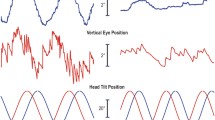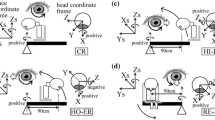Abstract.
We recorded three-dimensional eye movements elicited by velocity steps about axes that were tilted with respect to the earth-vertical. Subjects were accelerated in 1 s from zero to 100°/s, and the axis of rotation was tilted by 15°, 30°, 60°, or 90°. This stimulus induced a constant horizontal velocity component that was directed opposite to the direction of rotation, as well as a modulation of the horizontal, vertical and torsional components with the frequency of the rotation. The maximum steady-state response in the horizontal constant-velocity component was much smaller than in other species (about 6°/s), reaching a maximum at a tilt angle of about 60°. While the amplitude of the horizontal modulation component increased up to a tilt angle of 90° (8.4°/s), the vertical and torsional modulation amplitudes saturated around 60° (ca. 2.5°/s). At small tilt angles, the horizontal modulation component showed a small phase lag with respect to the chair position, which turned into a small phase lead at large tilt angles. The torsional component showed a phase lead that increased with increasing tilt angle. The vertical and torsional velocity modulation at large tilt angles was not predicted by a recent model of otolith-canal interaction by Merfeld. Agreement between model and experimental data could be achieved, however, by introducing a constant force along the body's z-axis to compensate for the gravitational pull on the otoliths in the head-upright position. This approach had been suggested previously to explain the direction of the perceived subjective vertical during roll under different g-levels, and produced in our model the observed vertical and torsional modulation components at large tilt angles.
Similar content being viewed by others
Author information
Authors and Affiliations
Additional information
Electronic Publication
Rights and permissions
About this article
Cite this article
Haslwanter, T., Jaeger, R., Mayr, S. et al. Three-dimensional eye-movement responses to off-vertical axis rotations in humans. Exp Brain Res 134, 96–106 (2000). https://doi.org/10.1007/s002210000418
Received:
Accepted:
Issue Date:
DOI: https://doi.org/10.1007/s002210000418




